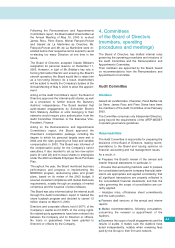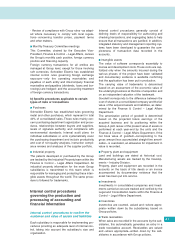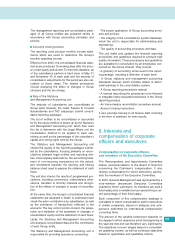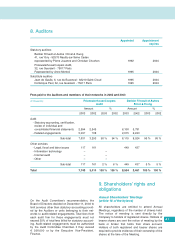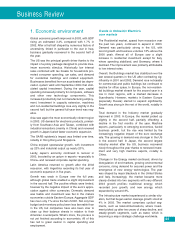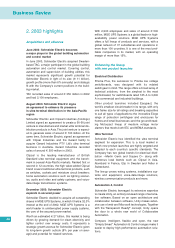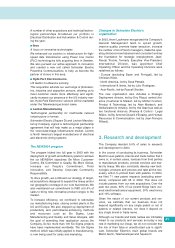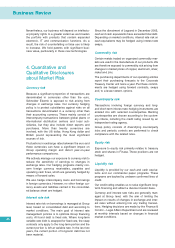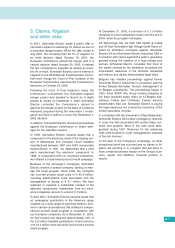APC 2003 Annual Report Download - page 39
Download and view the complete annual report
Please find page 39 of the 2003 APC annual report below. You can navigate through the pages in the report by either clicking on the pages listed below, or by using the keyword search tool below to find specific information within the annual report.
- Review of compliance with Group rules –as adapt-
ed where necessary to comply with local regula-
tions– concerning transfer prices, payment terms
and other matters.
■Monthly Treasury Committee meetings
This Committee, chaired by the Executive Vice-
President, Finance & Control – Legal Affairs, reviews
the Group's monthly cash position, foreign currency
position and financing capacity.
Foreign currency transactions for all entities are
managed at Group level, except for those involving
soft currencies. Schneider Electric has established
internal control rules governing foreign exchange
exposure –only the operating receivables and
payables of each entity and intercompany financial
receivables and payables (dividends, loans and bor-
rowings) are hedged– and the accounting treatment
of foreign currency transactions.
b) Specific procedures applicable to certain
types of risks or transactions
■Purchases
Schneider Electric has established rules governing
metal and other purchases, which represent in total
40% of consolidated sales. These rules mainly con-
cern purchasing department organization and proce-
dures, relationships between buyers and suppliers,
levels of signature authority, and compliance with
environmental standards. Internal audit plans for
individual subsidiaries or units systematically cover
the purchasing department and include productivity
and cost of non-quality analyses, instruction compli-
ance reviews and analyses of the supplier portfolio.
■Industrial property
The patents developed or purchased by the Group
are tracked by the Industrial Property team within the
Finance & Control – Legal Affairs Department. All
industrial property information for the main Group
subsidiaries is transmitted to this team which is
responsible for managing and protecting these intan-
gible assets throughout the world. The same proce-
dure is followed for trademarks.
Internal control procedures
governing the production and
processing of accounting and
financial information
Internal control procedures to confirm the
existence and value of assets and liabilities
Each subsidiary is responsible for implementing pro-
cedures providing an adequate level of internal con-
trol, taking into account the subsidiary's size and
organization.
Internal control procedures generally consist of
defining levels of responsibility for authorizing and
checking transactions, and segregating tasks to help
ensure that all transactions are justified. In addition,
integrated statutory and management reporting sys-
tems have been developed to guarantee the com-
pleteness of transaction data recorded in the
accounts.
■Intangible assets
The value of software corresponds essentially to
license and development costs. These costs are cap-
italized only when the amounts incurred during the
various phases of the project have been validated
and documentary evidence is available confirming
that the application has been put in production.
The carrying value of trademarks is determined
based on an assessment of the economic value of
the underlying business at the time of acquisition and
on an independent valuation of the trademark.
Goodwill corresponds to the difference between the
cost of shares in a consolidated company and the fair
value of the acquired assets and liabilities, as deter-
mined by the Finance & Control – Legal Affairs
Department.
The amortization period of goodwill is determined
based on the projected future earnings of the
acquired business and its positioning within the
Group. A joint review of the present value of assets is
performed at each year-end by the units and the
Finance & Control – Legal Affairs Department. If the
net book value of goodwill –corresponding to the
gross amount less accumulated straight-line amorti-
zation– is overstated, an allowance for impairment in
value is recorded.
■Property, plant and equipment
Land and buildings are stated at historical cost.
Manufacturing assets are tracked by the Develop-
ments – Industry Division.
Property, plant and equipment are recorded in the
accounts on the basis of title deeds or an invoice
accompanied by documentary evidence that the
asset has been put into service.
■Investments
Investments in consolidated companies and invest-
ments carried at cost are tracked and verified by the
Legal and Consolidation teams within the Finance &
Control – Legal Affairs Department.
■Inventories
Inventories are counted, valued and –where appro-
priate– written down by the subsidiaries, based on
Group policies.
■Trade receivables
When sales are recorded in the accounts by the sub-
sidiaries, this automatically generates an entry in a
trade receivables account. Receivables are valued
and –where appropriate– written down by the sub-
sidiaries in accordance with Group policies.
37








